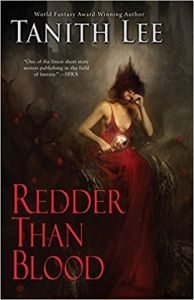Redder Than Blood by Tanith Lee (book review)
There has long been a tradition of folk or fairy tales, particularly in European Culture. The sanitised stories that most of us remember from childhood are very different from the original tellings. Many, we are led to believe, were told mainly by women to warn children about the dangers in the wider world. Often, these seemed to be aimed at young women to prepare them for lives as wives and mothers. In modern times, writers have taken these stories and retold them for contemporary children. Fantasy authors, in particular, are drawn to them. Of the late Tanith Lee’s many short stories, it is inevitable that she would use the magic of these tales. ‘Redder Than Blood’ is a collection of nineteen of them. The volume also shows how one story can be interpreted in different ways.
Both ‘Redder Than Blood’ and ‘Snow Drop’ have Snow White at their heart. Never expect a straightforward retelling from Lee’s pen. She takes the elements of a traditional tale and twists them. It is up to the reader to solve the puzzles she sets.
In the first of these stories, ‘Redder Than Blood’, a young man on his travels visits the home of a long dead poetess known as the Red Lily. Edmund is in love with her poetry and the portraits he sees of her show her as dark-haired, white-skinned and red-lipped. He knows her story but seems to be transported back to her court when in the presence of the images. It is a story where the usual ingredients are hidden but present.
The latter story, ‘Snow Drop’, is more direct. Christena is left by her husband for long periods in a house which is haunted by paintings by his previous wife. When a circus comes to town, she sees the acrobat who performs with seven dwarfs as the child in the pictures.
As many of the original tales were designed to warn of the iniquities of men, so two of the ‘Sleeping Beauty’ based stories ‘She Sleeps In A Tower’ and ‘Awake’ show men in a poor light. In one as treating women as sex objects and in the other as suggesting that marriage is a trap taking away freedom. In both of these and other stories, she is playing with the original material as there is no suggestion that in life, she espoused the views hinted at.
The three Cinderella-based stories all roughly follow the traditional pattern but have different motivations. In ‘The Reason For Not Going To The Ball’ men, including her father and the prince are painted as sexual monsters. In contrast, the prince in ‘Midnight’ is happy to marry Elvira despite all her clothes turning to rags at midnight. The prince in ‘Empire Of Glass’ sees the material the glass slipper is made from as a potential weapon. Taken together they show different facets of the male of the species. ‘Kiss, Kiss’, based on the Frog Prince, is another story that warns of the iniquities of men, especially if you give in and give them what they want.
The young man in ‘Rapunzel’ redresses the balance. Urlenn is a younger son of the king and on his way home from battle when he meets and falls in love with a peasant girl. Since he has a fiancé waiting for him that he doesn’t like, he has to find a way for his father to accept his preferred bride. To this end, he invents the story of ‘Rapunzel’. As a counter to this story, ‘Open Your Window, Golden Hair’ takes the same story but shows how inexperienced youth can he distracted and he falls into a trap laid for him by his own curiosity.
‘Bloodmantle’ and ‘Wolfed’ both represent the themes in ‘Red Riding Hood’ which is already regarded as a warning about the natures of men. The first has resonances of Angela Carter’s ‘The Company Of Wolves’, while the second turns the story upside down and Wolfgang is taken home by Rose as a birthday present for the woman she calls Gran. Here it is the women that have the ‘wicked’ intentions. While this story is very much present day, the majority of these are set in that indeterminate place that folk tales often find themselves.
‘The Beast’ and ‘The Beast And The Beauty’ are both love stories up to a point. In the first, the beast is not the outward appearance of Vessavion that is monstrous but his obsession. Isobel is happy with him until she uncovers his secret. In the second, his friends are surprised that the handsome bachelor marries the ugly woman. Here the beast is jealousy, that he can be happy with someone without perfect looks. Both the stories examine the nature of what a beast is.
The longest story in the book is ‘My Life As A Swan’. Notoriously, a first person narrative can be considered as from an unreliable witness. In this case, the story can be regarded as a straightforward result of Otila encountering an Enchanter, who teaches her how to transform herself into a swan. Conversely, it is the ramblings of an old woman who is either fantasising or who genuinely believes something that is untrue.
These and the other stories in this volume all show an immense degree of invention. While lesser authors might tell the traditional tale but transpose it into a modern setting, Lee takes the basic elements of the tale and plays with them. The result is startlingly original stories. A must for the bookshelf of any fantasy reader.
Pauline Morgan
August 2017
(pub: DAW. 309 page enlarged paperback. Price: $16.00 (US), $22.00 (CAN). ISBN: 978-0-7564-1251-7)
check out website: www.dawbooks.com


